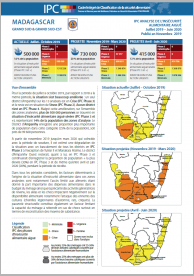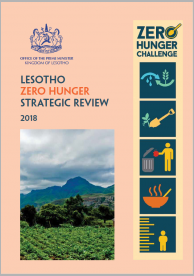
A food insecurity analysis for the period between July 2019 and June 2020.
Poor precipitation, desertification, pronounced absence of precipitation.
The following is a list of all conten labeled as "Drought"

A food insecurity analysis for the period between July 2019 and June 2020.

Lesotho experienced drought from the start of the winter season up to date. The results of which is felt across the whole country whereby most of the districts reported water shortages for both human and livestock consumption. Water levels in many water bodies and underground water have been deteriorating since 2012 and this has negative impacts on different sectors.

The main objective was to analyse food and nutrition security, and vulnerability of the population of Lesotho in 2019/2020 consumption year. Provide policy makers, government and other stakeholders with information for decision making and development programming.

In order to address the challenges that inhibit the country’s potential to achieving zero hunger by 2030, the Government commissioned the Lesotho Zero Hunger Strategic Review (LZHSR) report.

This paper provides an overview of what climate change will mean to subsistence and smallholder farmers in Lesotho, and how the capacity for climate change adaptation in agriculture can be strengthened, focusing on selected areas of crops, livestock and forest-based livelihood systems, to stabilize and improve yields.

The NCCS will provide a coherent and consolidated response to climate change. This strategic document will remain a “working” document intended to be updated and revised on an ongoing basis in response to new challenges and opportunities.

The purpose of the Regional Indicative Strategic Development Plan is to deepen regional integration in SADC. It provides SADC Member States with a consistent and comprehensive programme of long-term economic and social policies. It also provides the Secretariat and other SADC institutions with a clear view of SADC's approved economic and social policies and priorities.

This report provides detailed findings of an investigation into the socioeconomic impacts of the 2015/16 El Niño drought in Swaziland. It records the direct and indirect effects of the drought on the economy of Swaziland and documents how it has affected households, businesses, and the environment.

The SADC Gender Responsive Disaster Risk Reduction Strategy and Plan of Action: “Prevent Risk Creation and Reduce Existing Risks for Women, Men, Girls and Boys” 2020-2030 (GRDP) is designed to enhance regional capacities for gender-responsive disaster risk prevention, management and coordination in support of humanitarian assistance.

The National Disaster Management Agency (NDMA) commissioned a Mid-Term Review (MTR) in November 2016 supported by the Swaziland UN Country Office focusing primarily on the period beginning from the National Emergency Response Mitigation and Adaptation Plan (NERMAP) launch (February 2016) to December 2016.